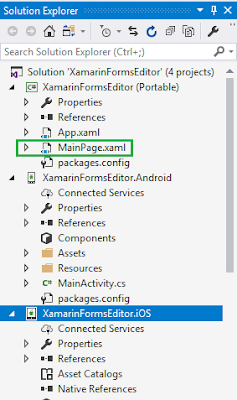In this blog, you will learn how to Store Images On App Directory in Xamarin iOS.
Introduction
Xamarin is a platform to develop cross-platform and multi-platform apps (for example, Windows phone, Android, iOS). In Xamarin platform, the code sharing concept is used. In Xamarin Studio, Visual Studio is also available.
Browse Code Here
Prerequisites
- Xamarin Studio.
- Xcode.
The steps given below are required to be followed in order to Store Images On App Directory in Xamarin iOS, using Xamarin Studio.
Step 1
Go To Xamarin Studio.
Click New Solution—> select iOS—>select App--> Choose single View App. Afterwards, click Next.
Step 2
In this step, configure your app. Give the app name (Ex:sample), Organization Identifier. Afterwards, click Next.
Step 3
In this step, give your project name (Ex: Sample) and solution name (Ex: Sample). Give the path of your project. Afterwards, click Create.
Step 4
Subsequently, go to the solution. In the solution, get all the files and sources in your project. Now, select Main.storyboard and double click to open Main.storyboard page.
Step 5
After opening the Main.storyboard, you can design this page, as per your desire.
Step 6
In this step design your app.using storyboard, Toolbox and Properties.
- Button(btnStore).
- Label(lblPath)
- ImageView(imgProfile).
Step 7
In this step, add the Image form your Local system.
Go to Solution—>Resource-->Right click-->Add-->Add Files.Now, you can choose the required Image. Click open.
Next, choose Copy the Files to the directory. Afterwards, click Ok.
Step 8
In this step, go to the ViewController.cs page. write the code given below.
ViewController.cs
using System;
using System.IO;
using Foundation;
using UIKit;
namespace XamariniOSImageStore
{
public partial class ViewController : UIViewController
{
protected ViewController(IntPtr handle) : base(handle)
{
// Note: this .ctor should not contain any initialization logic.
}
string fileName;
string folderPath = Environment.GetFolderPath(Environment.SpecialFolder.Personal);
int Count = 0;
public override void ViewDidLoad()
{
base.ViewDidLoad();
// Perform any additional setup after loading the view, typically from a nib.
}
partial void UIButton8_TouchUpInside(UIButton sender)
{
StoreImage("Xamarin.jpg");
}
public void StoreImage(string filename)
{
if (File.Exists(fileName))
{
Count++;
string filenames = "image" + Count.ToString() + ".jpg";
fileName = Path.Combine(folderPath, filenames);
}
else
{
fileName = Path.Combine(folderPath, "image.jpg");
}
var img = UIImage.FromFile(filename);
NSData image = img.AsJPEG();
NSError err = null;
image.Save(fileName, false, out err);
lblPath.Text = "File Path:" + fileName;
imgProfile.Image = UIImage.FromFile(fileName);
}
public override void DidReceiveMemoryWarning()
{
base.DidReceiveMemoryWarning();
// Release any cached data, images, etc that aren't in use.
}
}
}
Step 9
Now, go to Run option , choose Debug and the list of iPhone and iPad simulators, which are available. You can choose any one simulator and run it.
Output
After a few seconds, the app will start running on your iPhone simulator.You will see your app working successfully.
You can click Store Button, The image will be Store Successfully.
After, Go to check your App Directory
Summary
This was the process of how to Store Images On App Directory in Xamarin ios , using Xamarin Studio.























































